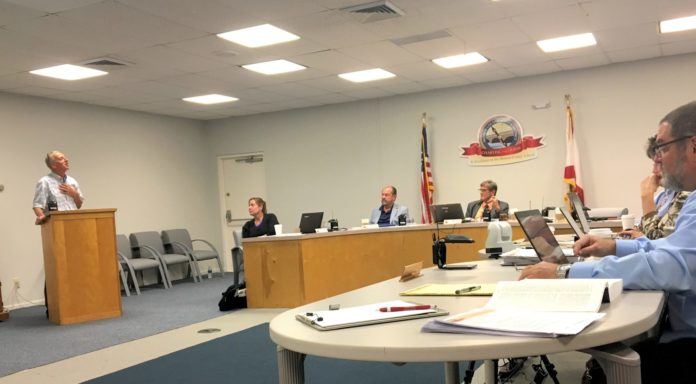Key West Attorney Robert Cintron speaks to the Monroe County School Board, citing President Franklin D. Roosevelt’s Lend-Lease Program. “Teachers are the most valuable resources for any community to have,” he said. “Please give serious thought to this without being forced into corners by rules,” he said.
‘This is not rocket science’
Monroe County School Board Member Andy Griffiths said the time is now to start moving forward on a housing project on school board-owned property at Sugarloaf School for teachers and school personnel. The rest of the board seemed to be in agreement but wanted more answers about the problems the project could face.
Retired builder Niels Hubbell said concrete modular homes would fit the criteria. “You could be putting people in them in six to nine months,” he said, offering pro-bono help on the project. “All you have to do is start.”
The “just start” sentiment was echoed throughout the meeting by members of the public.
Rebecca Keenum, the counselor at Poinciana Elementary, said her teachers are scrambling to find homes. Last year, the school lost four highly qualified teachers because they couldn’t find affordable housing. Key West City Commissioner Sam Kaufman, who has two children at Poinciana, said all of those involved in government need to take action on this, and added that as of Tuesday, 319 Key West households were still in hotels. “The [City of Key West] commission would have your back,” he said.
Monroe County Mayor George Neugent said the Monroe County Commission would also have the board’s back. “I’m in support of projects like this taking place in the Upper, Middle and Lower Keys,” he said, adding that the suggested $1,500 rent would be truly affordable. Griffiths said earlier the project would be self-supporting once established. “Monroe County would provide allocations for this development. Let’s get started on this now.”
Monroe County Sheriff Rick Ramsay said he faces the same issues in housing his 600 employees. “The cost of living and affordable housing is always an issue,” he said. His office is looking into a 32-unit complex for its employees. “We have to be vigilant to get around the obstacles. We need to find the ways to be a part of the solution to solve the problems of the future.”
Peter Batty said the Key West Utility Board built 38 units in Key West for its workforce. “All of us belong in housing,” he said.
Chuck Licis spoke on behalf of two Lower Keys property associations and said there was no opposition, or no “not in my backyard,” from the groups regarding the Sugarloaf Key school project.
Jed Dodds, executive director of The Studios of Key West, said he has offered short-term housing to teachers at its artist housing. “I’ve seen it firsthand, the struggles of the teachers,” he said. “If there is ever an occasion to take a stand, Irma is that occasion.”
Mike Morawski, of the Ernest Hemingway House, said that three quarters of the housing shortage is the purchase price of the land, which the school board already owns. “This dialogue has been going on since 1970,” he said. “We could have had a lot of housing if we just would have started back then. … We need to take these talking points and add them into solutions.”
Florida Keys Outreach Coalition’s Stephanie Kaple said her organization has been assisting teachers for decades, “This isn’t an Irma problem. If we are sitting here in another decade discussing this issue, we won’t have teachers or a community. We have to give our teachers their best tools.”
Community activist Sandy Higgs was stern in her admonitions to the board, saying they dropped the ball post-Irma for their teachers. “I am so frustrated that you are the biggest employer, and teachers are breaking down because they have nowhere to live,” she said, mentioning the empty classrooms in the schools that could house teachers or space on school board land where trailers could have been brought in immediately. “I have been to two schools that have 37 displaced personnel and you have not been there to help them,” she said, ending with, “Do your jobs, all of you.”
Former school board member Robin Smith-Martin said yes to building the Sugarloaf project, but added that it’s just a Band-Aid on a bigger problem. “This is the result of greed and poor planning and we need to have a sustainable compact across the county for a long-term plan.” He said the board serves students and then added that the board did not create this problem and is not to blame.
Unable to attend the meeting, board member Bobby Highsmith said via letter that the highest priority has been the housing crisis in the Keys and he is strongly in favor of the Sugarloaf project.
At the end of the meeting, Griffiths pushed for a request for proposals by the end of the week, but chairman John Dick and board member Mindy Conn wanted questions answered. Dick mentioned the $7.2 million spent for the Marathon Manor property, as well as issues regarding alcohol, tobacco, and firearms on school property. He also questioned whether housing should be developed by a private party or managed by the school board. Some of those in attendance pushed for the board to make a decision that evening to move forward with Sugarloaf project.
“Does anyone think I am going too fast?” Griffiths asked those in attendance. Some yelled back, “No,” and “You’re not going fast enough.”
“If we can’t do it now, then when,” said Griffiths. “Make this a priority.”
“I don’t want to do something that is going to cause us grief in the future,” Dick said.
“How are 20 little houses for our teachers going to cause us grief?” said Griffiths.
Superintendent Mark Porter said the district will move forward aggressively with this project. Dick said the board is going forward with this, and The Weekly would be the first to know when the RFP is ready.
“This is not rocket science. This is a first, critical, historic step for a government agency to get off their bottoms and do something.” — Andy Griffiths, school board member
























